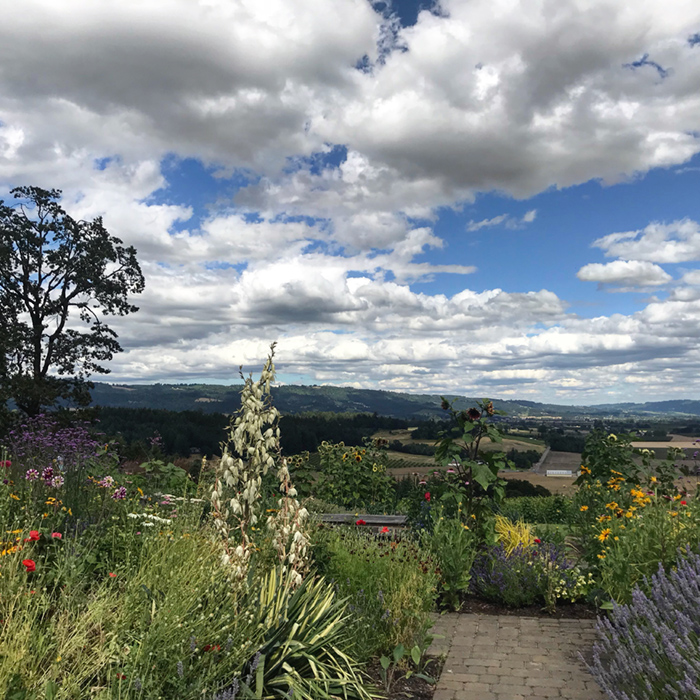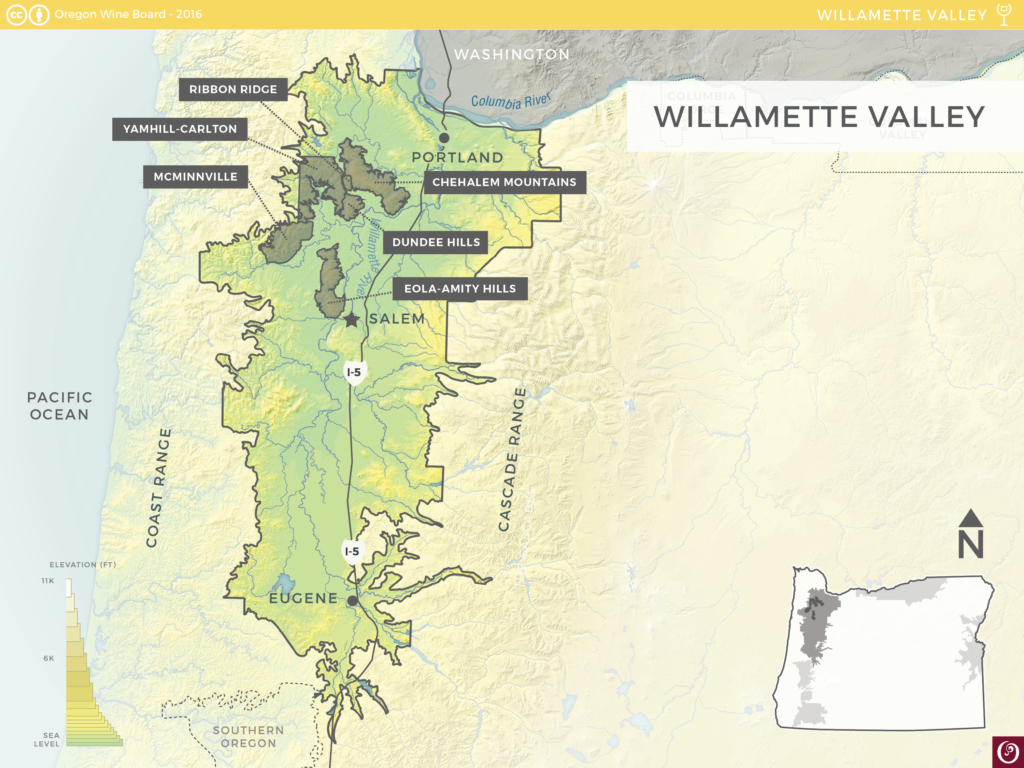
View from Penner-Ash winery. Photo credit: Fred Swan
For the past decade, the Willamette Valley AVA has been one of the most-respected in the country. It's Pinot Noir wines are particularly high-scoring. Because their overall quality level is high and production limited, the wines average price points are high too. But Willamette Valley is not a small, homogenous region. This article is a quick guide to understanding the Willamette Valley AVA.
The Willamette Valley AVA is huge in total area.
It stretches from the Columbia River in the north to well south of the city of Eugene, nearly 150 miles north to south. It’s 60 miles across at the widest point. Total area is 3,438,000 acres or 5,372 square miles. That’s almost as big as the entire state of Connecticut [5,543 m2].

Map: Oregon Wine Board
Vineyard density in the Willamette Valley AVA is very low.
Unlike places such as Burgundy and Napa Valley, the Willamette Valley is not a monoculture. There's a wide range of agricultural activity, including row, field and orchard crops, plus livestock ranching. Total vineyard acres in the Willamette Valley are just 21,793. That’s less than half the planted acres of Napa Valley, despite the latter being 15 times smaller in total area.
Oregon ranks fourth among all US states for wine volume produced.
It’s vineyard acreage is third-highest, behind California and Washington and ahead of New York. However, Oregon has a strong quality focus and low-yields, so New York produces more liters of wine.
Despite it’s large size, there are only three major soil types in the Willamette Valley.
Marine sedimentary soil—ancient seafloor—is the oldest of the soils, dating back 200 million years. Tectonic movement and volcanoes covered some of the land with basalt 14-16 million years ago. Within the past 100,000 years, wind blew silt from the floodplains around the valley, creating a soil type called loess. The prevalence of these three soils, the way in which they are layered, their depth, and the degree to which they are decomposed differ from one zone, or vineyard, to another and give the wines unique signatures.
The Willamette Valley has a cool, maritime climate.
The Willamette Valley climate is dramatically affected by the Pacific Ocean, roughly 50 miles to the west, but the Coast Range of mountains blocks some of the cold air and precipitation. Rainfall isn’t high, about 29” on average. But, unlike California’s Mediterranean climate regions, rain can and does fall throughout the year. There is also substantial variance in weather from one year to the next, which leads to great differences in the wines from vintage to vintage.
The Willamette Valley has four distinct seasons with long, hot summer days, but a short growing season. It accumulates more degree days on average than the cool Santa Maria Valley AVA in Santa Barbara County—2,285 vs. 2,200—but Willamette Valley has more cloud cover, more rain, and a short season, so ripeness can be lower.
The Willamette Valley is a relatively young wine region.
While wine grapes were planted there in the 19th century, the industry didn’t survive Prohibition in any significant way. It wasn’t until the mid-1960s that anyone pursued serious viticulture again. Even then, growth was slow in the industry until the early 1980s.
Pinot Noir is the dominant variety.
It accounts for nearly 16,000 acres, more than three-quarters of all vineyard land. The next-most planted variety is Pinot Gris with 3,100 acres, then Chardonnay [1,500] and Riesling [500]. David Lett, of The Eyrie Vineyards, planted the valley’s first Pinot Noir vines in 1965.
The character of the Pinot Noir wines differs from AVA to AVA, by vintage, and based on producer intent. Generally speaking though, they are red fruited and savory. In most vintages, the wines are best with a few years of bottle age.

Linfield College: Willamette Valley Archival Photos - Eyrie
There are six smaller AVAs nested within the Willamette Valley AVA, and more are being created.

Map: Willamette Valley Wineries Association
- Chehalem Mountains AVA is the largest and highest altitude of the nested AVAs. It includes all three soil types. Undulating with ridges and valleys running in all directions, there is a lot of diversity among its 100+ vineyards.
- Ribbon Ridge AVA is nested within a western portion Chehalem Mountains AVA. Its soil is almost exclusively marine sedimentary and, being protected from sea breezes by adjacent hills, its weather is relatively moderate and consistent.
- Dundee Hills AVA was the first Willamette Valley zone to be planted with grapes in the modern era. It’s still the most densely planted with 1,700 acres of grapes within its 12,500 total acres. The soil is primarily basalt and the Coast Range shields the area from severe oceanic weather.
- Yamhill-Carlton AVA has ancient, well-drained, marine sedimentary soil. In the northwest of the Willamette Valley AVA, it’s isolated from the ocean by the Coast Range, the Chehalem Mountains, and the Dundee Hills. There are just 1,200 vineyard acres in this 60,000 acre AVA.
- The McMinnville AVA has varied, but shallow soils. There is also climatic variation, with the westernmost vineyards relatively dry, due to the rain shadow of the Coast Range. The southern portion of the AVA is a bit less dry and is cooled by breezes coming through a significant wind gap, the Van Duzer Corridor. The eastern portion of the AVA gets the most rain.
- The Eola-Amity Hills AVA, southernmost within the Willamette Valley, stretches from just south of McMinnville to just north of Salem. It’s more influenced by the Van Duzer Corridor than any other, established AVA. This leads to substantial temperature drops late in the day and wines relatively high in acid. The soils are generally basalt with various amounts of sedimentary and loess mixed in.
- Next to be approved—it could be any day now—will be the Van Duzer Corridor AVA. It’s in the direct path of winds coming through the gap and will be the coolest of all the nested AVAs.
JJ Buckley has a good selection of well-regarded Willamette Valley wines representing different nested AVAs. Note that many Willamette Valley wineries make wine from a multiple vineyards, not all of which are in the same nested AVA as the winery. You can consult maps at the WVWA or AVA websites to figure out where particular vineyards are.
JJ Buckley guest blogger Fred Swan is a San Francisco-based wine writer, educator, and authority on California wines and wineries. His writing appears in The Tasting Panel, SOMM Journal, GuildSomm.com, Daily.SevenFifty.com, PlanetGrape.com, and his own site, FredSwan.Wine (formerly NorCalWine). He teaches at the San Francisco Wine School. Fred’s certifications include WSET Diploma, Certified Sommelier, California Wine Appellation Specialist, Certified Specialist of Wine, French Wine Scholar, Italian Wine Professional, Napa Valley Wine Educator and Level 3 WSET Educator. He's twice been awarded a fellowship by the Symposium for Professional Wine Writers.